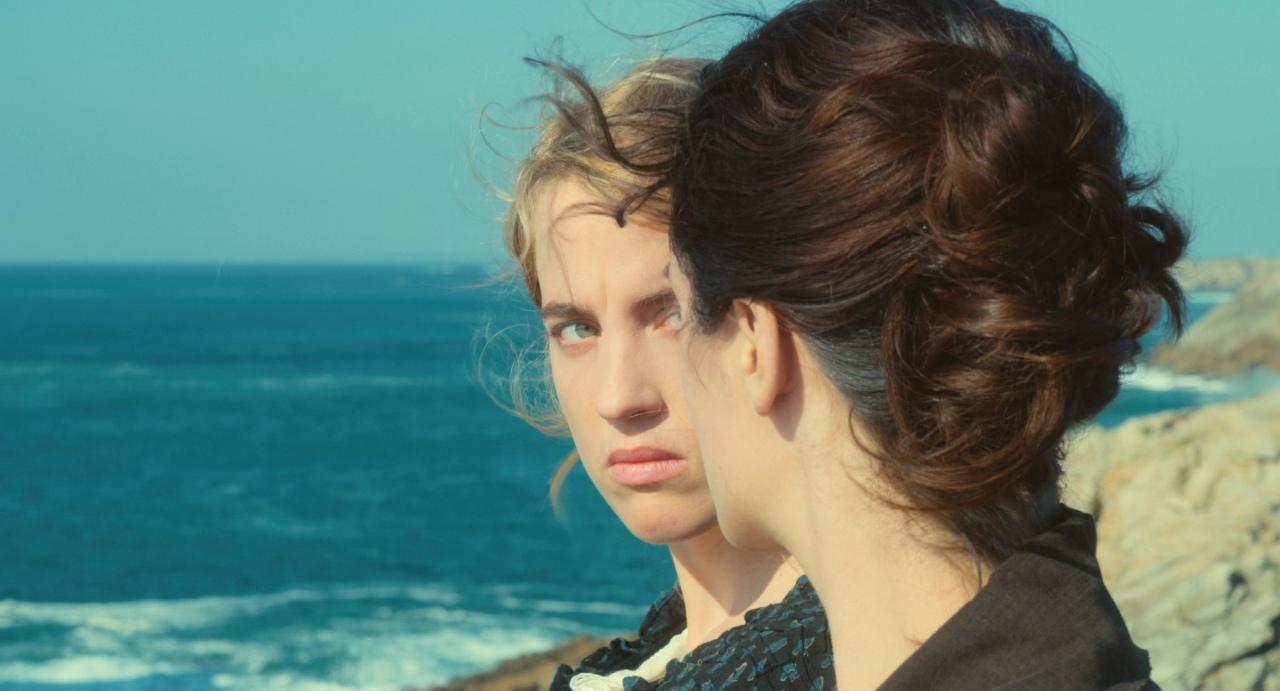In classical Hollywood films, “A woman’s attempt to be both subject and object of the gaze has backfired” (Balsom, 2020). In patriarchal culture, female characters can only be gazed at, they don’t have the same right to gaze as the male ones do.
However, the film Portrait of a Lady on Fire (Portrait de la jeune fille en feu, Céline Sciamma, 2019) has revolutionized the way that female characters are represented. The reality of the patriarchy is embodied as the male gaze in cinema: female figures will consciously or unconsciously serve men’s pleasure and subject themselves to men. This article will explore several feminist ways that the film Portrait of a Lady on Fire (hereinafter reffered to as Portrait) has subverted the dominant male gaze by relating to articles from Mulvey and Balsom and arguing that women can be represented in a desexualized and equal manner under female gaze.

Mulvey (1975) discussed “the unconscious (formed by the dominant order) structures ways of seeing and pleasure in looking” (p. 2). Unconsciousness of the objects being watched constitutes cinematic visual pleasure. “Mainstream film coded the erotic into the language of the dominant patriarchal order” (Mulvey, 1975, p. 3). The film industry interweaves “erotic pleasure” (Mulvey, 1975, p. 3) with patriarchal culture, especially through representation of the “image of woman” (p. 3).
Feminist Subversion of Gaze: Invite Female Gaze
To understand how Portrait employs female gaze, I will first relate to the notion of voyeurism (“pleasure in looking” [Mulvey, 1975, p. 6]), which is to “tame threats to male spectators posed by female characters” (Rushton & Bettinson, 2010, p. 89). Female characters, under the secret gaze of voyeurism, will often be punished to assert male control. Mulvey (1975) argues that secretly watching others offers “sexual satisfaction” (p. 4) by making the spectators feel they can control and objectify others because this creates a “pleasure in looking at another person as an erotic object” (Mulvey, 1975, p. 12). The spectators will peep unrestrictedly in cinema, particularly the female figures, who are hence designed to satisfy “erotic pleasure” (Mulvey, 1975, p. 3) and “voyeuristic phantasy” (p. 4). “In a world ordered by sexual imbalance, pleasure in looking has been split between active/male and passive/female. The determining male gaze projects its phantasy onto the female figure which is styled accordingly” (Mulvey, 1975, p. 6). The representation of passive female figures is moulded by the way that the active male interprets women. The voyeurism leads to an inequality of gaze in cinema– – women are considered as sex objects, they can only be looked at and possess no power to look back. However, Portrait has denied such voyeurism. At first, Marianne (Noémie Merlant) attempted to peep at Héloïse (Adèle Haenel) to finish her portrait (Fig. 1), but Héloïse immediately gazed back at her (Fig. 2). At this stage, Marianne represents a potential male gaze from Héloïse’s future husband because her job is to create Héloïse’s portrait for him . Marianne’s failure in “voyeurism” (to watch Héloïse secretly) has indicated that male gaze is unwelcome in this film. Later, when Marianne concedes that she is a painter and shows Héloïse the finished portrait, Héloïse asks disappointedly, “Is that how you see me?” and critiques that there’s no vitality or presence of life in her portrait, which are the defects of the male gaze. When Héloïse agrees to pose, she asks Marianne, “When you’re observing me, who do you think I’m observing?”. This places them in equal positions and shows Héloïse is conscious of Marianne’s gaze. That’s where female gaze is embodied as Brey (quoted in Balsom, 2020) defined, “there exists a female gaze, a gaze that makes us feel the experience of a female body on screen” and “representing women […] as subjects of desire”. Women are conscious subjects in this film.
Feminist Subversion of Narrative: Female Subjectivity
The film reinterprets the Greek myth of Orpheus and Eurydice. The original story is about how the male gaze can kill women. But Héloïse stresses the subjectivity of Eurydice, “Perhaps she was the one who said, ‘turn around”. This reinterpretation negates the traditional “to-be-looked-at ness” of female characters and men as the “‘bearer of the look’, tasked with advancing the narrative” (Balsom, 2020; Mulvey, 1975, p. 6). The later conversation between Marianne and the critic shows Eurydice’s transformation from an unseen object to a central protagonist (Fig. 3). This plot is to rebuke the female figures’ functions in traditional male gaze films, they do not contribute to the plot development, except for “as erotic object for the characters within the screen story, and as erotic object for the spectator within the auditorium” (Mulvey, 1975, p. 6). Boetticher (quoted in Mulvey, 1975, p. 6) also stated that, “What counts is what the heroine provokes, or rather what she represents […] In herself the woman has not the slightest importance”. However, Héloïse’s reinterpretation grants Eurydice her own mind and motivation, her obscure image which existed only to support Orpheus has now become vivid. Through the female gaze, she has gained control over her own fate.
Feminist Subversion of Objectification: Feminine Identity
Near the end, Héloïse cries to Marianne, “Do not imagine me guilty”. She wants Marianne to know she is unlike any objects Marianne painted before, she is unruly and cannot be possessed. Mulvey (1975) described the objectification process, “woman displayed as sexual object is the leit-motif of erotic spectacle” (p. 6). Male gaze deprives women of mobility and imagines women as docile sex objects. “Female gaze means avoiding the objectification of women’s bodies” (Balsom, 2020). Men’s imagination generates a distorted image of women to objectify them and wipe their identities. This dialogue shows a “principle of equality” rather than “control and mastery” (Balsom, 2020). The pleasure in a female gaze film does not come from “objectifying a person through gaze, like a voyeur” (Balsom, 2020). Héloïse doesn’t accept blame because she is equal to Marianne instead of being a subordinated object. What’s more, Klinger’s essay illuminates “a particular structuring of female experience that focuses on momentous shift in identity and self-recognition” (Klinger, 2006, p. 40, quoted in Rushton & Bettinson, 2010, p. 85). It emphasizes the importance of feminine identity, which, for Héloïse, is independence.
This film rejects “conventional forms of sexualization” (Balsom, 2020); it represents marginalized women in patriarchal society and channels the protagonists’ feelings. It subverts the voyeuristic pleasure of male gaze, grants women subjectivity and denies sexual objectification to female characters while challenging the male-dominant cinema through feminist perspectives. The film has demonstrated the possibility of representing women in a desexualized and equal means unsing the female gaze.
Bibliography
Balsom, E. (2020). In search of the female gaze. Cinema Scope.
Mulvey, L. (1975). Visual pleasure and narrative cinema. Screen, 16(3), 6–18.
Rushton, R., & Bettinson, G. (2010). What Is Film Theory? Maidenhead: McGraw-Hill Education.
Filmography
Portrait of a Lady on Fire / Portrait de la jeune fille en feu (2019) dir. Céline Sciamma, France
Written for The Film Dispatch by Yangwen ‘Yvonne’ Wang.

